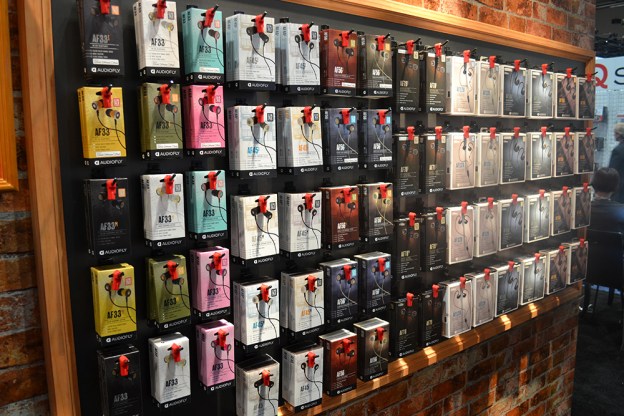
Check out our review of the Audiofly AF-78 headphones.
In the world of audio, Australia-based Audiofly is barely a baby. Founded in 2010, Audiofly officially launched its line of in-ear headsets at CES last year. But after visiting the fledgling company’s booth, one thing is sure: Audiofly is on the move at a lightning fast pace, and doesn’t seem to be slowing down anytime soon.
This year Audiofly won a CES Innovation Award for it’s hybrid dynamic-balanced armature-driven headset, the AF-78, which retails for about $200. After listening to the earbuds, we can see why. Though we weren’t able to do an official test, we took the AF-78 for a spin around the block and were amazed by what we heard. The headset revealed brilliant clarity, smooth tone, and an incredibly exciting transient pace to some of our favorite tracks. In fact, our initial impression is that the AF-78 might just be one of the best in-ear headsets we’ve ever heard.

However, that’s not what all the buzz is about at the Audiofly booth these days. The AF-78 is old hat compared to the all new line-up of prototypes Audiofly brought to CES – release date unknown. The crown jewel of the new lineup is the AF-160. Touting three separate armature drivers with crossover, the AF-160 is supposed to bring an elemental, organic sound to the music, with professional-grade clarity and transient speeds. We were amazed by the clarity they revealed in our quick test-listen, giving an almost surgically clean definition to the sound. Every tap, click, pick strum and lip movement was showcased with pinpoint accuracy. The AF-160 is supposed to be an “affordable” monitor for performance, and possibly studio mixing, and for that they are probably fantastic. However, while understanding the sound is still being tweaked, we’d actually prefer the tone of the AF-78 to the 160 for everyday listening.

A nice balance between the two was met in the AF-120. The 120 takes a bit of the laser detail of the AF-160, and a bit of the AF-78’s warmth to bring a very flat, and pleasant presentation of the frequency spectrum, creating fast transients with a very soft touch. At present time, we think many consumers might feel more at home with the sound of the AF-78 and the AF-120 to the AF-160 – but again, we’d have to spend more time with all the headsets to give our full opinion.
We don’t have any pricing yet for the new prototypical headphone line, but if you’re curious, take the $200 AF-78 and adjust up accordingly. Suffice it to say, we were pretty impressed by what Audiofly has to offer, even if it’s new line-up is going to be a bit pricey. And given Audiofly’s prolific output, coupled with the fact that the company is just getting started, we’re excited to see what’s in the pipeline for next year’s CES. Either way, get your ears (and wallets) ready for some awesome in-ear headphones, coming soon.
Editors' Recommendations
- First listen: EarFun’s first over-ear headphones are impressive for $80
- JBL’s first open-ear earbuds have a detachable neckband


